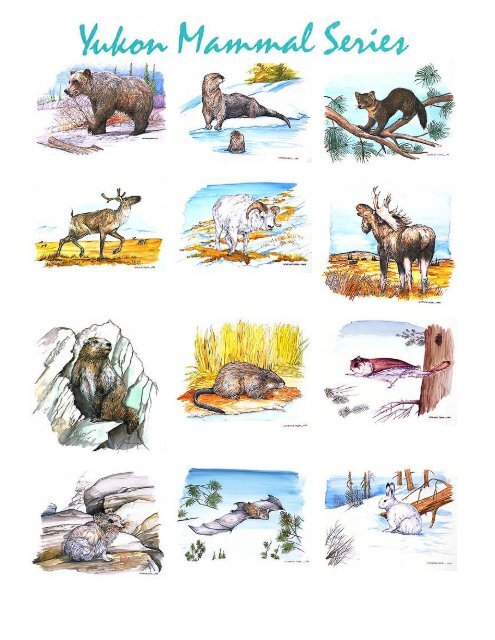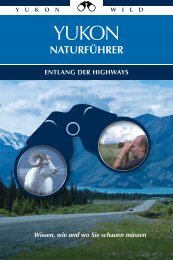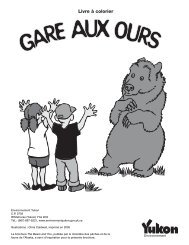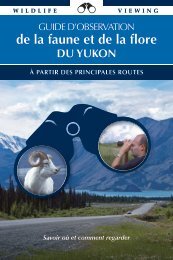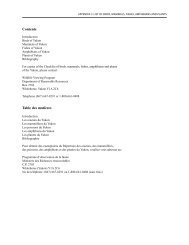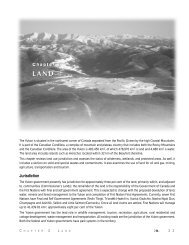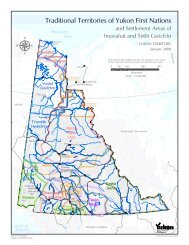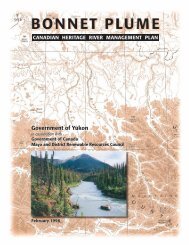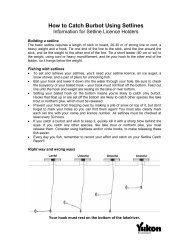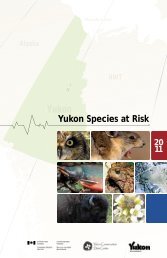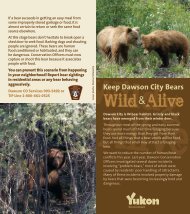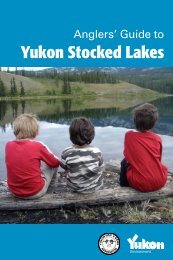You also want an ePaper? Increase the reach of your titles
YUMPU automatically turns print PDFs into web optimized ePapers that Google loves.
Table of Contents<br />
(Click Animal Name to Jump to Page)<br />
Animal Page<br />
Shrews 1<br />
Collared Pika 3<br />
Snowshoe Hare 5<br />
Red Squirrel 9<br />
Northern Flying Squirrel 13<br />
Arctic Ground Squirrel 15<br />
Beaver 19<br />
Deer Mouse 23<br />
Voles 25<br />
Lemmings 29<br />
Muskrat 33<br />
Jumping Mice 35<br />
Porcupine 37<br />
Whales 39<br />
Coyote 43<br />
Wolf 45<br />
Arctic Fox 49<br />
Red Fox 51<br />
Black Bear 53<br />
Grizzly Bear 57<br />
Polar Bear 61<br />
Marten 63<br />
Fisher 65<br />
Ermine & Least Weasel 67<br />
Mink 71<br />
Wolverine 73<br />
River Otter 75<br />
Lynx 77<br />
Caribou 79<br />
Moose 83<br />
Wood Bison 87<br />
Mountain Goat 89<br />
Thinhorn Sheep 91<br />
Least Chipmunk 95<br />
Little Brown Bat 98<br />
Hoary Marmot 101
THE FAMILY:<br />
Soricidae<br />
Portrayed in the idyllic summer<br />
season with its warm and dewy<br />
days, it would seem that the tiny<br />
masked shrew leads a blissful life.<br />
But "bliss" is likely to be an unfamiliar<br />
term to a shrew. With such<br />
a hectic hunt-and-eat pace, it seems<br />
a wonder that shrews survive in<br />
Arctic and sub-Arctic regions at all.<br />
These smallest of mammals (the<br />
pigmy shrew is the second smallest<br />
mammal in the world) are not well<br />
insulated and they can perish from<br />
exposure within a few short<br />
minutes. Yet in the Yu<strong>kon</strong> alone<br />
there are five different species and<br />
all are thriving and active yearround.<br />
CHARACTERISTICS:<br />
Worldwide, shrews are a very<br />
successful family . Wi th a fifty<br />
million year history and a wide<br />
distribution across North America,<br />
their lifestyle works. The key lies in<br />
living at a fast and furious pace.<br />
A Yu<strong>kon</strong> shrew, like all North<br />
American shrews, is active day and<br />
night in a near-constant game of<br />
hunt and eat. Being the size of a<br />
thumb or less, and weighing no<br />
more than a nicket a shrew is like a<br />
tiny jet engine: it must consume<br />
relatively large amounts of fuel and<br />
quickly convert it into energy. A<br />
shrew's high rate of metabolism is<br />
characterized by a heartbeat of 1200<br />
beats per minute - the same as that<br />
of a hovering hummingbird. To<br />
maintain that rate of living, a diet of<br />
easily digestible, high energy food,<br />
is essential.<br />
One best source of such food is<br />
insect life. But how do shrews find<br />
insects in winter? Surprisingly, insect<br />
eggs, larvae, pupae and dormant<br />
adults are still present, often at<br />
ground level where the shrew hunts<br />
and in most circumstances, such insect<br />
food is more than ample for a<br />
shrew's needs.<br />
"Ample" in a shrew's perspective<br />
means eating one's own weight in<br />
food each day. For a pregnant<br />
female, an adequate food supply<br />
can amount to three times her<br />
weight per day. This task is accomplished<br />
by being fast and aggressive.<br />
With front teeth that are<br />
designed for grasping and quickly<br />
cutting up its prey, this little insectivore<br />
scurries through natural or<br />
mouse-made passageways, attacking<br />
and eating any suitable object in<br />
its path.<br />
Nowhere is efficiency a more important<br />
word than when it is applied<br />
to shrews living through the seasons<br />
in the Yu<strong>kon</strong>. Whether arctic tundra<br />
or boreal forest, minimizing energy<br />
and water loss is an essential. One<br />
way of doing this is to live in<br />
sheltered habitats that reduce the<br />
loss of soil warmth and moisture.<br />
1
4<br />
suitable vegetation is nearby - usually<br />
within five to six metres of its<br />
home.<br />
Food for a pika takes the form of<br />
a wide variety of succulent<br />
greenery: nearly all plants in the<br />
vicinity, including leaves of mountain<br />
avens, lupines, vetch, dwarf<br />
huckleberry, kinnikinnik, and<br />
grasses. As summer commences,<br />
much of the abundant food is cured<br />
in the dry mountain air, usually in<br />
"haystacks" among the rocks. These<br />
haystacks can become quite large -<br />
as much as 3S centimetres high and<br />
60 centimetres across. Usually a<br />
pika puts most of its effort into producing<br />
one large haystack but may<br />
also store small amounts in scattered<br />
locations. The habit of<br />
building haystacks is essential to a<br />
pika's survival because North<br />
American pikas do not hibernate<br />
and must have food for winter.<br />
LIFE AROUND A HAYSTACK<br />
A haystack often forms the<br />
center point of each pika's territory<br />
which usually covers about 400<br />
square metres. Socially, pikas will<br />
tolerate each other at a minimum<br />
distance of about 20 metres but a<br />
greater distance of 7S metres is<br />
preferred. As a result, pika territories<br />
are often strung out in a<br />
well-spaced line along the perimeter<br />
of a talus slope.<br />
Much of a pika's calling is<br />
thought to be a declaration of, "this<br />
is my territory", which helps reduce<br />
the need to fight or chase one's<br />
neighbor away. Although fights<br />
seem to be rare, chasing one's<br />
neighbor is still a part of everyday<br />
life. Occasionally a call will announce<br />
the presence of a predator<br />
such as a hawk, owl, grizzly or ermine<br />
(short-tailed weasel). The ermine<br />
is one of the most effective<br />
predators because it is small enough<br />
to pursue a pika through the maze<br />
of crevices in a talus slope. Fortunately,<br />
ermine feed on a wide<br />
variety of mice and other small<br />
mammals and do not decimate pika<br />
colonies.<br />
The loss of part of the population<br />
to predators and other factors is<br />
compensated through the birth of<br />
two to five young in late spring and<br />
possibly again in mid-summer. Living<br />
within their parent's territory for<br />
part of the summer, they will move<br />
into available vacant habitat by ear<br />
Iyautumn.<br />
--<br />
d<br />
a<br />
High temperature can be a<br />
critical factor to pika survival but it<br />
seems irrelevant for northern pikas<br />
which can easily avoid the occasional<br />
heat wave by retreating to a<br />
cool environment under the rocks.<br />
PIKAS AND PEOPLE<br />
Aside from their aesthetic value,<br />
the Yu<strong>kon</strong>'s pikas are safe from<br />
predation by humans. For those<br />
who enjoy the hiking and climbing<br />
in alpine terrain, the call of the pika<br />
is a welcome sound in the often<br />
quiet landscape. Amongst the<br />
Southern Tutchone, it was considered<br />
bad luck to bother a pika,<br />
with foul weather being the<br />
predicted consequence.<br />
Distributio n of Co llared Pika<br />
VIEWING OPPORTUNITIES<br />
Since pikas are daytime animals,<br />
they are out and about at the same<br />
time as most people. Aside from the<br />
fact that they are quite specific to<br />
talus slopes, usually above treeline,<br />
they are easily found because of<br />
their call. However, although they<br />
are heard, they are not necessarily<br />
easy to see. Usually I it is necessary<br />
to spend many minutes watching in<br />
the direction of the sound (if the<br />
direction can be determined!) until<br />
the pika's movement is discerned.<br />
The pika's lower pitched call is quite<br />
different from the squeak of an arctic<br />
ground squirrel and the whistle<br />
of a marmot.<br />
Pikas are approachable as long<br />
as you have considerable patience.<br />
By moving very slowly and quietly,<br />
with no sudden flinches or hand<br />
movements, you may be able to approach<br />
very closely. Once near its<br />
home territory, you may find that<br />
the pika will approach within a few<br />
metres - or centimetres - if you<br />
are able to remain nearly motionless<br />
and quiet for a few minutes. It seems<br />
that pikas are sufficiently curious to<br />
come and check you out before going<br />
back to their busy chore of<br />
haymaking.<br />
.,<br />
•<br />
7.6 em<br />
it<br />
• I<br />
26.5 em<br />
••<br />
•<br />
J<br />
"<strong>kon</strong><br />
Renewable Resources
THE SPECIES:<br />
Lepus Americanus<br />
White fur against white snow, a<br />
snowshoe hare crouches among willow<br />
stems. Its presence is betrayed only by<br />
black, marble-like eyes that scan the<br />
wintry world in a constant surveillance<br />
for predators. Too late, those eyes spot<br />
a lynx stalking on silent paws. Exploding<br />
from cover, hunter and hunted<br />
leap, bound, and merge in a flurry of<br />
snow. Then the hare lies still.<br />
Known as a "rabbit" to most Yu<strong>kon</strong>ers<br />
and a "bunny" to some, the snowshoe<br />
hare fascinates us with its 10year<br />
cycle of rising and falling<br />
popula tions. It is the single most<br />
important prey species in the territory.<br />
DISTRIBUTION<br />
Widespread, and head-scratchingly<br />
abundant in peak years, the snowshoe<br />
hare has a range that stretches across<br />
North America. It inhabits brushy<br />
forests from Alaska to Newfoundland,<br />
and south into the mountains of the<br />
eastern and western United States.<br />
Snowshoe hares occur throughout<br />
the Yu<strong>kon</strong> Territory wherever patches<br />
of shrub and forest intermingle. While<br />
forest is used for shelter from severe<br />
winter storms and predators, shrubs<br />
are u sed for food. Some favourite<br />
habitats are willow thickets and burn<br />
areas with regenerating pine and<br />
aspen. Areas like these, often recently<br />
disturbed, contain thick stands of<br />
tasty, nourishing and accessible shrubs.<br />
Individual snowshoe hares occupy<br />
areas up to nine hectares in size, but<br />
mos t of the ir acti vity takes p lace<br />
within an area a third this size. As<br />
numbers build to a peak in the 10-year<br />
cycle, hares spread from pockets of<br />
prime habitat to fill every available<br />
space. During the last hare cycle, densities<br />
of Yu<strong>kon</strong> hares climbed from<br />
one hare in 50 hectares during the low<br />
of 1976 to four hares in a single hectare<br />
during the peak of 1980-81 - an<br />
astonishing 200-fold increase.<br />
CHARACTERISTICS<br />
Since the Yu<strong>kon</strong> is home to only<br />
one long-earred, fluff-tailed hopper,<br />
you can be sure anyone you see is a<br />
snowshoe hare. Yu<strong>kon</strong> hares weigh<br />
one to two kilograms and may reach<br />
half a metre in length. Their "snowshoes"<br />
are very broad hind feet padded<br />
thickly w ith bristly hairs. Like your<br />
own snowshoes, these feet distribute<br />
the hare's weight over a large surface<br />
area and a llow it to move on deep<br />
snow without sinking in more than a<br />
few centimetres.<br />
The snowshoe hare is a source of<br />
food for nearly every mammalian and<br />
avian predator of our northern forests.<br />
To evade its many hunters, the hare<br />
has developed two strategies. The first<br />
is camouflage, whereby this species<br />
earns its alternate name of "varying<br />
hare". Twice a year the snowshoe hare<br />
5
6<br />
tra d es its fur coa t fo r another tha t<br />
more closely matches its surroundings.<br />
In w inter the hare's silky pelage is<br />
snow-white with black-tipped ears; in<br />
summer it is rusty or dark brown with<br />
touches of cinnamon, white, and black.<br />
Since the moults a re triggered b y<br />
daylength rather than snowfall, hares<br />
are very conspicuous when snowfall is<br />
late or lasts longer than usuaL<br />
The snowshoe hare's second escape<br />
strategy involves wariness, speed and<br />
agility. Large eyes set high on its head<br />
a llo w the hare to see in nearly a ll<br />
directio ns, w hile long ear s swivel<br />
independently to pick up sounds. As<br />
long as it remains undetected, the hare<br />
hold s its ground, forefeet tucked back<br />
between h ind fe et, read y to bo u nd<br />
away.<br />
With rear limbs much longer than<br />
front ones, the hare's body is built like<br />
a sou ped -up racing car - high in the<br />
back and low in the front. Fused hind<br />
foot bones pack a powerful push-off, a<br />
r educed collarbone pe rmits freeswinging<br />
leg movements, and a skull<br />
formed o f pitted bones lightens the<br />
hare's load.<br />
Once d etected, the snowshoe hare<br />
leaps into action, jumping, bound ing,<br />
zigging and zagging. It's been clocked<br />
a t speeds of u p to 50 kilometres per<br />
hour, and ca n cover three metres in a<br />
single bound . When pushed, it takes to<br />
the water and swims strongly, those<br />
broad snowshoes doubling as paddles.<br />
A lthough often out and about on<br />
cloudy winter afternoons, snowshoe<br />
hares are active primari ly a t d awn,<br />
dusk, and during the night. In the daylight<br />
hours, they rest in shallow depressions<br />
calle d forms, w h ich may be<br />
tucked beneath a snow-laden branch<br />
or deadfall. There they doze or groom<br />
themselves.<br />
Durin g rest p eriods, h ares also<br />
excrete and then eat soft, green pellets<br />
of pa rtly digested food. In much the<br />
same way as a cow or sheep chews<br />
and digests its food twice, these pellets<br />
go back into the hare's bag-like digestive<br />
chamber. There, mo re nutrients are<br />
extracted before hard, fully digested<br />
pellets are passed.<br />
With evening's approach, snowshoe<br />
hares hop from their shelter in search<br />
of food along the ed ges of forests and<br />
thickets. So familiar are they with their<br />
ho me ra nges that they know ever y<br />
trail, every clearing, and every hiding<br />
spot. With their li ves riding o n th e<br />
quick escape, they pack snow paths<br />
Snowshoe Hare distribution<br />
hard and fast in winter.<br />
HOPPING THROUGH THE<br />
SEASONS<br />
White spruce needles fall in a circle<br />
on the snow as a snowshoe hare moves<br />
round a young tree, stripping clean its<br />
slender twigs and eating them. At the<br />
edge of a clearing, it neatly clips dwarf<br />
birch and willow twigs. In a meadow,<br />
it d igs through the snow to feed on<br />
last summer's horsetails, then nibbles<br />
at evergreen leaves and shoots of bearberry<br />
and twinflower in the w oods<br />
nearby. Other popular w in ter foods<br />
are the twigs, buds, and bark of aspen,<br />
balsam poplar, and lodgepole pine, as<br />
well as mats of dryas.<br />
As snowcover builds higher and<br />
covers low shrubs, ha res u se their<br />
snowshoes to stay on top of it. There<br />
they trim and girdle shrubs and trees<br />
to heights tha t surprise summertime<br />
strollers. Hares may choose particular<br />
foods having above-average protein<br />
content, and w ill stand u p right, hop<br />
onto low branches, and d ig craters in<br />
the s now to o btain the ir fa vourite<br />
dietary delights.<br />
When the fresh winds of late February<br />
and March promise spring soon to<br />
come, male hares are possessed by the<br />
mating u rge. Primed a nd read y a<br />
month before females, they leap and<br />
race about, burning off their unfulfilled<br />
a rdo ur an d fitting the d escription<br />
"mad as a Ma rch hare!" In late April,<br />
w he n breeding sea son does start,<br />
males become very aggressive and<br />
may fight over females.<br />
In the southern Yuko n, the first<br />
"bunny" litters are born in late May.<br />
Unlike true rabbits, which dig burrows<br />
an d make fu r o r p lant-lined n ests<br />
within, hares simply drop their you ng<br />
into a shallo w d e pressio n o n the<br />
ground under a deadfall or at the base<br />
of a tree. However, the newborn hares,<br />
called leverets, are more highly developed<br />
than young rabbits. They have<br />
eyes open, are fully furred, and can<br />
hop on their first d ay of life. Within a<br />
week they speed away from d an ger<br />
and begin to feed on plants.<br />
Snowshoe hares are casual parents.<br />
The male d oes not care for the young<br />
at all, and the female visits her young<br />
as little as once a day to feed them.<br />
Each day the leverets separate a nd<br />
find a sheltered spot w here they remain<br />
alone. They return to a central location<br />
at feeding time w hich, here in the<br />
Yu<strong>kon</strong>, is around midnig ht. Their<br />
mother arrives quickly, suckles them<br />
fo r two to fi ve m inutes, and t h en<br />
dep arts. This low-contact pa rental<br />
strategy may d ecrease the chances of<br />
leverets being killed by predators.<br />
In the Yu <strong>kon</strong>, snowshoe hares have<br />
up to four litters between May and<br />
September, twice as many as in Colorado.<br />
The fi rst litter, averaging three<br />
young, is s ma ller tha n second a nd<br />
third litters, but has survival rates u p<br />
to twice as high. Later litters may have<br />
a tougher go of it becau se, as young<br />
predators grow up, the number of hare<br />
hunters builds up steadily throughout<br />
the summer.<br />
Our hares also prod uce more young<br />
each year than sou ther n s nowshoe<br />
hares - roug hly twice as many a s in<br />
Ontario and Minnesota. It seems that,<br />
even tho u g h Yu<strong>kon</strong> summ ers are<br />
shorter tha n sou thern summers, our<br />
longer d ays affect the hormonal cycle<br />
of hares, increasing their productivity.<br />
This may be a response to the high<br />
mortality suffered by northern hares,<br />
compared w ith lower mortality a nd<br />
more com petition between hares and<br />
rabbits in the south.<br />
Many juvenile h a res di e o r are<br />
killed within the firs t few weeks of<br />
life, and 15% or less survive to breed<br />
the next spring. A host of hawks, owls,<br />
eag les, and terrestria l hunters take<br />
both adults and young . Ch ief among<br />
the latter is the snowshoe hare's arch<br />
enemy, the ly nx. However, coyotes,<br />
foxes, wolves, fishers, martens, min ks,<br />
and wolverines also take their tolL<br />
As spring g ives w ay to summer
and then to autumn, grasses, herbs,<br />
and shrubs sprout, flourish and wilt.<br />
So does the snowshoe hare's interest<br />
in particular plants as food. Short-term<br />
specialists, hares switch onto the nutrient-rich<br />
new growth of boreal forest<br />
plants in the order that it appears.<br />
Grass shoots green the forest floor<br />
first, and the hare devours them.<br />
Sprouts of bearberry, horsetails, and<br />
the new leaves of lupine and willows<br />
follow as the growing season wears<br />
on. When the frosts and storms of<br />
September and October whip bright<br />
leaves to the ground, the snowshoe<br />
hare is once again left with its winter<br />
menu of twigs and dormant shoots.<br />
THE lO-YEAR CYCLE<br />
Like small ghosts on a winter's<br />
night, snowshoe hares race and bound<br />
in a clearing, their tracks covering the<br />
snow. A few years later the hares are<br />
gone, and their familiar tracks are<br />
rarely sighted. Of all the cyclic ups<br />
and downs of animal populations in<br />
subarctic regions, it is the 10-year cycle<br />
of the snowshoe hare that is the most<br />
striking.<br />
The hare cycle ranges from eight to<br />
eleven years in length. It happens at<br />
the same time across thousands of<br />
miles of snowshoe hare range. Here<br />
and there, isola ted hare hotspots<br />
appear, then spread like a wave across<br />
the land, to be followed in a few years<br />
by the crash. The timing of the rise<br />
and fall of hare numbers is the same,<br />
w ithin one or two years, over all of<br />
Canada and Alaska. Yet, in the most<br />
southern part of its range, where<br />
ecosystems are more stable and diverse,<br />
the population does not cycle at all.<br />
Yu<strong>kon</strong> hare densities in the last<br />
cycle began to increase in 1976 and<br />
peaked during 1980 and 1981. Hare<br />
numbers began to decline during the<br />
winter of 1981-82 and the decline continued<br />
until 1983.<br />
Like snowshoe hare populations in<br />
Alberta and Minnesota, Yu<strong>kon</strong> hares<br />
had peak spring densities of two to<br />
four hares per hectare. However, our<br />
lowest hare densities were ten times<br />
lower than in the more southern areas.<br />
As well, numbers of Yu<strong>kon</strong> hares<br />
dropped from peak to low in only two<br />
years, much faster than the three years<br />
in Minnesota and four in Alberta.<br />
Why? Perhaps because a simpler food<br />
chain in the north leads to higher<br />
death rates.<br />
And just what drives the snowshoe<br />
hare cycle? This question has puzzled<br />
northerners and scientists for generations.<br />
On a broad scale, it may be the<br />
22-year sunspot cycle and its effects on<br />
boreal forest weather patterns or forest<br />
fires. On a narrow scale, it may involve<br />
disease or the production of toxins by<br />
some of the hare's favourite shrubs.<br />
Two vital components in the cycle<br />
equation are known to be food supply<br />
and predation.<br />
An on-going study at Kluane Lake<br />
has shown that food does not have to<br />
be in short supply for hare numbers to<br />
decrease. It has also shown that predation<br />
claims most hare lives in the<br />
winter following peak numbers. Key<br />
questions being asked at Kluane now<br />
concern the interaction of food supply,<br />
predation, and the survival of young<br />
hares.<br />
The ups and downs of the snowshoe<br />
hare cycle affect more than just one<br />
species. During peaks, hares may compete<br />
with moose for browse. The lynx,<br />
another snow walker, feeds almost<br />
exclusively on hares, its numbers<br />
shadowing the rise and fall of the hare<br />
population. The coyote population<br />
also cycles here in the north, but being<br />
a more general hunter, the coyote is<br />
affected less by hare cycles than the<br />
lynx. Other mammalian predators are<br />
affected even less.<br />
However, when hares are scarce,<br />
other prey are sought by all of the hare<br />
hunters. Like a ripple that spreads<br />
from a single stone thrown in the<br />
water, the good and bad fortunes of<br />
the snowshoe hare touch every part of<br />
the boreal forest ecosystem.<br />
SNOWSHOE HARES AND<br />
PEOPLE<br />
Snowshoe hares have always been<br />
an important food source for Yu<strong>kon</strong>ers<br />
in remote areas and are still our most<br />
popular small game species. Although<br />
pelts are no longer sold in the fur<br />
trade, furs are used locally for mukluk<br />
trim and other crafts.<br />
In the old days, Indians sometimes<br />
starved when rabbits were scarce. But<br />
when hare numbers soared, the people<br />
joined together to herd them like<br />
caribou into snares. They built long,<br />
low, fences of brush that came together<br />
in a V-shape, or stretched straight<br />
fences end to end. Then, shouting and<br />
beating the brush with sticks, the hare<br />
hunters drove their panicking quarry<br />
into snares set in the fences. The snowshoe<br />
hares provided not only food, but<br />
warmth as well. Their skins were<br />
peeled off in long strips and woven<br />
into blankets and parkas that were<br />
light and warm.<br />
VIEWING OPPORTUNITIES<br />
Your chances of spotting snowshoe<br />
hares will depend largely on which<br />
phase of the 10-year cycle they are in.<br />
Numbers are expected to peak around<br />
1990, so keep this in mind when you<br />
7
THE SPECIES:<br />
Tarniasciuytls hudsonicus<br />
Perched on a limb, tail aloft, a red<br />
squirrel chews seeds from a spruce<br />
cone. Alerted by voices, it "chucks"<br />
out a challenge, then scolds when<br />
footsteps move closer. The most<br />
widespread of North American squirrels,<br />
this bold tree d weller is the bestknown<br />
mammal of Yu<strong>kon</strong> forests.<br />
DISTRIBUTION<br />
The Ted squirrel inhabits boreal<br />
forests from Atlantic to Pacific, ranging<br />
north to treeline and south into the<br />
mountains of the eastern and western<br />
United States.<br />
Here in the Yu<strong>kon</strong>, red squirrels<br />
chatter and chase throughout forests<br />
to the edge of alpine and Arctic tundra.<br />
Unlike many other mammals, they<br />
prefer to live among mature evergreens,<br />
where dense branches offer them<br />
highways through the sky, and they<br />
can gather plenty of cones for food.<br />
Our best red squirrel habitat is older<br />
white spruce forest, where squirrels<br />
reach densities of two to three per<br />
hectare. They also inhabit stands of<br />
black spruce, pine, and aspen or<br />
poplar mixed with conifers.<br />
CHARACTERISTICS<br />
One of the smallest of North America's<br />
tree squirrels, the red squirrel in<br />
the Yu<strong>kon</strong> reaches a length of 30 cm<br />
and a weight of 280 grams. It boldly<br />
advertises its presence and aggressively<br />
challenges any and all intruders that<br />
enter its particular patch of forest.<br />
Active by day, this feisty rodent<br />
attracts our attention with barked<br />
challenges and muttered threats. Its<br />
winter coat of rust and grey stands out<br />
in a snow-dusted world. In summer,<br />
it's cloaked in olive-brown and white,<br />
with a bright black line along its side.<br />
At home in the treetops, red squirrels<br />
race up and down trunks, gripping<br />
bark with curved claws and keeping<br />
balance with bushy, flattened tails.<br />
They cling to the undersides of<br />
branches, dash through the canopy,<br />
and leap spread-eagled to branches<br />
below or to the ground. Some fall tens<br />
of metres from the tops of trees, yet<br />
scamper away unhurt.<br />
On the ground, the red squirrel<br />
sticks close to trees, running quickly<br />
from the base of one to another until it<br />
gets where it's going. It occasionally<br />
takes to the water and swims strongly,<br />
sometimes covering distances that<br />
surprise summertime paddlers.<br />
Yu<strong>kon</strong> red squirre ls build oval<br />
nests of dried grasses and stick them<br />
firmly into the forks of tree branches.<br />
Some of these nests are used simply as<br />
platforms for sitting and eating.<br />
Others are filled with stores of mushrooms.<br />
Most nests are found about<br />
half-way up spruce trees, often tucked<br />
into the untidy clumps of witch's<br />
brooms (a witch's broom is an unnat-<br />
9
10<br />
urally thick growth of twigs that looks<br />
like a big lump on a spruce tree - it's<br />
caused by a parasitic fungus). Sheltered<br />
by the trees themselves, these nests<br />
have linings of grasses shredded so<br />
finely that the pieces resemble sawdust.<br />
GUARDING THE CONE<br />
CROP<br />
Lovers of conifer seeds, red squirrels<br />
rely on stored cones to carry them<br />
through the long northern winters.<br />
Their lives depend not only on finding<br />
enough cones to harvest, but also on<br />
d efending cone supplies from thieves.<br />
Both of these ends are achieved by the<br />
same means - territoriality. Individual<br />
squirrels occupy areas within the<br />
forest and d efend them from others of<br />
either sex.<br />
When a twig snaps in the squirrel's<br />
domain, it goes on defense, barking<br />
out a series of challenging "chuckchucks"<br />
punctuated by emphatic body<br />
jerks and tail flicks. If the intruder<br />
moves closer, the squirrel bursts into a<br />
frenzied chatter, feet s tamping a nd<br />
body quivering with aggression.<br />
If trespassers are ne ighbouring<br />
squirrels, territory owners may chase<br />
them out. However, red squirrels<br />
usually spend less than one percent of<br />
their time in defense of their territories,<br />
and of this, only a quarter involves<br />
chases - the rest is purely and loudly<br />
vocal.<br />
In the southern Yu<strong>kon</strong>, a red squirrel<br />
territory ranges from one-third to half<br />
a hectare in size and usually has the<br />
same boundaries year a fter year.<br />
Within this area, a the squirrel may<br />
harvest up to 16,000 cones in one<br />
season. Occasionally it caches them in<br />
a few small stockpiles scattered about<br />
its territory, but most often the squirrel<br />
stashes all its cones in a central storage<br />
depot called a midden.<br />
Middens are piles of bits and bracts<br />
from cones already eaten. They' re<br />
often found around the bases of large<br />
trees or under windfalls. Si nce red<br />
squirrels u se the same middens year<br />
after year, these piles of cone refuse<br />
grow in size with age. Older middens<br />
may be a metre deep and more than 20<br />
square metres in area.<br />
CHATTERING THROUGH<br />
THE SEASONS<br />
Spring<br />
Red squirrels mate while the fresh<br />
winds and warm sun of spring slowly<br />
Red Squirrel distributiol1<br />
melt the boreal forest's carpet of snow.<br />
Zipping through trees overhead and<br />
racing across the fores t floor, they<br />
chase intruders and potential mates in<br />
w hat we see as games of high-speed<br />
tag.<br />
Female red squirrels allow males<br />
onto their territories for only one day<br />
during a breeding season that starts as<br />
early as late March and ends in mid<br />
May. On mating day, their scent attracts<br />
a group of males, and females mate<br />
w ith one or more suitors before banishing<br />
them once again to their own<br />
territories.<br />
About a month after mating, female<br />
red squirrels give birth to three or four<br />
young. Like red squirrels throughout<br />
most of Canada, Yu<strong>kon</strong> females pr
THE SPECIES:<br />
Glaucomys sabrinus<br />
Clinging to the trunk of a spruce<br />
tree twenty metres above the forest<br />
floor, a northern flying squirrel<br />
turns head down, gathers its<br />
muscles, and leaps into space. With<br />
four limbs spread wide, the loose<br />
skin between them stretched out. to<br />
create a parachute effect, the squirrel<br />
glides for fifty metres, twisting<br />
and turning through the trees. Approaching<br />
its chosen landing site, it<br />
swoops upward at the last moment,<br />
checking its speed before settling onto<br />
the lower trunk of another large<br />
spruce. The squirrel quickly<br />
scrambles a few metres up the tree<br />
before pausing to survey its new<br />
surroundings.<br />
The northern flying squirrel is<br />
fairly common in Canada's boreal<br />
forests, but because it is a nocturnal<br />
species, few people have ever seen<br />
one. Most Yu<strong>kon</strong>ers are unaware of<br />
the flying squirrel's presence in the<br />
territory .<br />
DISTRIBUTION<br />
Since the flying squirrel has been<br />
little studied in the Yu<strong>kon</strong>, its local<br />
distribution is not well known. It is<br />
thought to occur from the B.C.<br />
border north to Dawson City, but<br />
the exact northern limit of its range<br />
has not been documented.<br />
This squirrel inhabits dense coniferous<br />
forests with large mature<br />
trees, and is likely confined to lower<br />
elevations in the Yu<strong>kon</strong>.<br />
CHARACTERISTICS<br />
Thanks to its long tail and the<br />
mass of skin folded along its flanks,<br />
the northern flying squirrel appears<br />
to be almost the same size as the red<br />
squirrel. But with its delicate body<br />
structure, it is considerably lighter.<br />
Weights range from 75 to 140<br />
grams, about half the weight of a<br />
,<br />
\<br />
II<br />
red squirrel. The northern flying<br />
squirrel is larger than the southern<br />
flying squirrel which occupies south<br />
eastern North America.<br />
Brownish grey fur on the top<br />
surface of the flying squirrel's body<br />
contrasts sharply with the pale,<br />
cream colored underparts.<br />
The loose skin that extends from<br />
wrist to ankle is folded along its<br />
flanks when not "in flight" . These<br />
membranes, which make the flying<br />
squirrel less agile on the ground<br />
than the red squirrel, function<br />
beautifully in the air. Spurs of cartilage<br />
extending back from the<br />
wrists help to spread the folds of<br />
skin. With the aid of its flattened<br />
tail , the flying squirrel is able to<br />
bank and turn in mid-glide. The<br />
large luminous eyes of a nocturnal<br />
hunter contribute to the flying<br />
squirrel's unique appearance.<br />
LIFE HISTORY<br />
Northern flying squirrels pro-<br />
13
14<br />
bably mate in late March and April,<br />
with females giving birth to an<br />
average of three young in May. The<br />
young are born in a tree nest from<br />
one to ten metres above the ground.<br />
The nest may be a renovated bird<br />
nest, a mass of twigs, moss, and<br />
shredded bark arranged aroung the<br />
base of a branch, or an abandoned<br />
woodpecker hole or other cavity in<br />
the tree trunk. Tree trunk nests are<br />
thought to be more commonly used<br />
in winter.<br />
At forty days old, young flying<br />
squirrels are walking well but are<br />
unable to glide. Occasionally, a<br />
mother will glide while holding one<br />
of the young with her mouth. At<br />
three months of age, the young<br />
begin their gliding lessons, and by<br />
September they are as mobile as<br />
their parents. Young females will be<br />
ready to breed the following spring.<br />
Unlike red squirrels, flying<br />
squirrels are very sociable. Several<br />
adults may feed in a group, and<br />
nests are often located close<br />
together. In Alaska, as many as 20<br />
flying squirrels have been found<br />
sleeping in a single communal<br />
winter nest.<br />
Northern flying squirrels sleep<br />
through the daylight hours and rise<br />
to feed after dark. In southern parts<br />
of their range, peaks of activity are<br />
thought to occur at 11 P.M. and<br />
again at 3:30 A.Moo Flying squirrels<br />
are not active during windy nights,<br />
but may be out foraging in late<br />
afternoons on cloudy days. It is not<br />
known how the long daylight hours<br />
of the Yu<strong>kon</strong> summer and the long<br />
periods of darkness in winter affect<br />
the activity patterns of this nocturnal<br />
mammal.<br />
The primary foods of the northern<br />
flying squirrel are tree lichens,<br />
fungi, and the buds, leaves, seeds<br />
and fruit of many trees and shrubs.<br />
It also eats insects, bird eggs, and<br />
fledgling birds, and may scavenge<br />
off any carcasses in the area. Much<br />
of its foraging is done on the<br />
ground. Cones are stored in tree<br />
cavities and nests for the winter,<br />
and these supplies allow the squirrels<br />
to remain near dormant in their<br />
nests during blizzards and period of<br />
extreme cold.<br />
.- L<br />
,<br />
Flying squirrels glide from one<br />
tree to another to forage, but also to<br />
escape predators. Owls are their<br />
main predator, but foxes, weasels,<br />
marten, and even lynx and wolves<br />
occasionally eat flying squirrels.<br />
Distribution of Nortl1ern Flying Squirrel<br />
FLYING SQUIRRELS AND<br />
PEOPLE<br />
As noted earlier, most Yu<strong>kon</strong>ers<br />
are unaware of the flying squirrel's<br />
existence. It is occasionally caught<br />
in traps set for other furbearers, but<br />
its pelt has no market value.<br />
The true value of this unique and<br />
mysterious mammal may lie in the<br />
wonder and appreciation for nature<br />
that it inspires in many people.<br />
VIEWING OPPORTUNITIES<br />
How do you view a small animal<br />
that only comes out at night? Well,<br />
usually you don't, but there are exceptions.<br />
More than one Whitehorse<br />
resident has been fortunate enough<br />
to have a flying squirrel land on a<br />
bird feeder near a window.<br />
During the longest days of a<br />
Yu<strong>kon</strong> summer, the dark hours are<br />
short and still fairly well lit. Since<br />
the squirrels will be more visible,<br />
this may be the best time to look for<br />
them in dense, mature spruce<br />
forests, or to visit a nest you may<br />
have located.<br />
Knocking on the trunk of a tree<br />
w ith a squirrel nest in it may bring a<br />
flying squirrel out, but be careful.<br />
Continued harassment may cause<br />
the squirrels to abandon their nest.<br />
Flying squirrels are less active in<br />
winter, but you can sti ll look for the<br />
characteristic landing patch w ith<br />
tracks leading off in the snow.<br />
Landing mark __<br />
....<br />
... ,<br />
I, •<br />
"koH<br />
Renewable Resources
18<br />
-- L<br />
• \{.kOH<br />
Renewable Resources
20<br />
lightweights compared to Ontario<br />
beavers, some of which weigh almost<br />
twice as much. Poorer habitat and<br />
short growing seasons may explain<br />
why Yu<strong>kon</strong> beavers are smaller than<br />
southern Canadian beavers.<br />
CASTOR'S<br />
CONSTRUCTION CO.<br />
By tuning in to the noises made by<br />
water flowing over obstructions,<br />
beavers get their directions straight for<br />
damming. Then they use small, agile<br />
forepaws to push mud and stones into<br />
a ridge along their chosen site across a<br />
narrow stream or even a broad slough.<br />
With the whole family chipping in,<br />
they push sticks and logs into the<br />
muddy ridge for support, sometimes<br />
using the peeled remains of winter<br />
food caches. The n th ey add more<br />
muck and rock, and keep on building<br />
until the dam is high enough and long<br />
enough to prevent water from flowing<br />
over or around it. Instead, the trapped<br />
water seeps slowly through the dam,<br />
which acts more like a sieve than a<br />
blockade.<br />
A beaver dam may be more than<br />
three metres high and can stretch for<br />
hundreds of metres. Sometimes a dam<br />
spans an entire river and changes its<br />
course. The end result is a pond two to<br />
three metres d eep in which its architects<br />
can build a secure lodge and swim<br />
beneath the thickest ice of winter.<br />
Dams extend beavers' food-gathering<br />
range by flooding cut-over areas and<br />
giving access to new stands of shrubs<br />
and trees. They also kill shoreline trees<br />
and create new willow habitat. Frequent<br />
inspections and maintenance keep<br />
dams in good repair throughout the<br />
life of the colony.<br />
Home-builde rs too, beavers dig<br />
burrows in banks or build lodges of<br />
sticks and mud; some do a combination<br />
of both. ' Bank beavers' live on rivers,<br />
where currents sweep away sticks and<br />
make lodge·building difficult. 'Lodge<br />
beavers' li ve in qu ie t w aters, where<br />
you can find thei r houses tucke d<br />
against a s hore or completely surrounded<br />
by water.<br />
The beaver lodge, typically a mound<br />
of logs, sticks, and mud, rises above<br />
water level and has a nesting chamber<br />
within covered by a loose roof of sticks<br />
to allow for ventilation. An underwater<br />
tunnel near the bottom of pond o r<br />
stream gives beavers entry to their dry<br />
home and prevents entry by all predators<br />
except otters. The lodge dwellers<br />
Beaver distribution<br />
sleep and dry off on ledges surrounding<br />
the tunnel entrance. Water from wet<br />
coats filters down through a carpet of<br />
wood chips and fibers, keeping the<br />
lodge dry. Before cold weather sets in,<br />
b eavers winterize their homes by<br />
adding more layers to lodge roofs and<br />
smearing them with mud. When frozen<br />
solid and covered w ith snow, the<br />
lodges are snug and almost impossible<br />
to penetrate.<br />
THE SOCIAL SIDE OF LIFE<br />
Beaver life is a family affair that<br />
centres around an adult female. She<br />
chooses the colony's home site and,<br />
here in the north, mates with one male<br />
for life. Her mate and litters of one or<br />
more years make up the rest of the<br />
family circle. An average colony has<br />
five members, and a ll colonies live<br />
within small, well-defined territories<br />
that contain their ponds and food<br />
supplies.<br />
A beaver family works together to<br />
build and repair dams and lodges, and<br />
to prepare a winter food cache. When<br />
k its are young, all family members<br />
bring them leafy branches and herbs to<br />
eat. The adult male brings them most<br />
o f their solid food, a n unusual trait<br />
among mammals. By the time autumn<br />
arrives, kits are ready to take part in<br />
the gathering of food for winter.<br />
With all the time and effort spent in<br />
the building and maintenance of dams<br />
and lodges, beavers have to protect<br />
the ir in ve s tmen ts. During spring<br />
break-up, w hen ju ven iles are on the<br />
move in search of s ites to set up or<br />
take over colonies, a n established<br />
colony goes on the defense. The whole<br />
family piles mounds of plants and<br />
mud on shore, then marks them with<br />
castoreum. These sign posts set territory<br />
boundaries and let dispersing beavers<br />
know the ages, sexes, and reproductive<br />
condition of family members. They not<br />
only discourage intruders, but also let<br />
dispersing beavers know if an adult<br />
has been lost and needs replacing.<br />
Juveniles leave their home colony<br />
a t one to three years of age. T hey<br />
travel by land and water, sometimes<br />
more than 150 kilometres, in search of<br />
sites w here they can start their own<br />
colonies. En route, they o ften clash<br />
w ith members of established colonies,<br />
and many a beaver with a battlescarred<br />
pelt and torn tail has been seen.<br />
Although young beavers. are quite<br />
safe in their home colonies, about 90<br />
percent of disperSing yearlings and<br />
two-year-oIds are killed by predators,<br />
crus hed by moving ice, or die from<br />
diseases before they can establish a<br />
new colony. A few of those that succeed<br />
may reach the ripe old age of 20 years,<br />
but most beavers d ie at less than half<br />
that age.<br />
Many colonies go in cycles. Three<br />
to four years after a new colony establishes<br />
itself, it reaches its greatest size.<br />
After five or six yea rs, the colony<br />
begins to over-eat its food supplies.<br />
Fewer young are produced, fewer<br />
beavers survive the winter, and food<br />
supplies diminish. Eventually the<br />
colony abandons its site to avoid starvation.<br />
After a few years, the food supply<br />
may regrow to point where new<br />
beavers are able to move in. Where the<br />
colony has been surviving on temporary<br />
food sources such as fire-caused aspen<br />
s tand s, the site may be abandoned<br />
permanently.<br />
Some colonies are able to shift-their<br />
cutting operations up or down stream<br />
as food supplies diminish, and in this<br />
way are able to occupy the same colony<br />
site on a semi-permanent basis. Others<br />
may concentrate on temporary food<br />
sou rces s u ch a s fire ca u sed aspen<br />
stands.<br />
GNAWING THROUGH THE<br />
SEASONS<br />
While winter winds howl and temperatures<br />
plunge, a family of beavers<br />
sits tight in its lodge. Beneath the ice,<br />
they live in total darkness for up to 8<br />
months of the year, sleeping, eating,<br />
and grooming their waterproof fur
with split nails on two toes of each<br />
hind foot. Having cached branches<br />
and logs of willow, poplar, dwarf<br />
birch, and aspen near the lodge's<br />
entrance, they brave icy pond waters<br />
only to visit their pantry. Beavers eat<br />
twigs, leaves and buds, or gnaw at soft<br />
inner bark. In February and March,<br />
adults take to the water for a different<br />
reason - mating.<br />
When the ice melts, juveniles leave<br />
their home colonies and the rest of the<br />
beavers get busy. They patrol their territories,<br />
scent-marking and challenging<br />
intruders. They sample the new leaves,<br />
twigs, bark, and buds of most plants<br />
growing in or near the water. Aspen is<br />
the beaver's first choice for cutting<br />
throughout North America, but is not<br />
widespread here in the Yu<strong>kon</strong>. Instead,<br />
willow is our beavers' main source of<br />
food, and they will eat spruce only<br />
when faced with starvation.<br />
In spring, beavers repair dams<br />
threaten ed by high water. They also<br />
build new ones to flood an even larger<br />
area and bring more trees and shrubs<br />
within easy reach. Later on, when<br />
water levels drop, they save energy by<br />
digging canals and floating logs to<br />
their ponds instead of dragging them.<br />
Early in summer, three or four kits<br />
are born within lodges or bank burrows,<br />
each weighing roughly half a kilogram.<br />
Fully furred and with incisors ready to<br />
chew, they can swim in the undenvater<br />
entrance within a few minutes. They<br />
start to eat leaves and herbs within a<br />
few days. At two weeks of age, kits<br />
make their pond debut and start slapping<br />
their tails soon after. Here in the<br />
north, beavers grow slowly throughout<br />
their first year, and then only in subsequent<br />
summers until they reach adult<br />
size at four years.<br />
With the first frosts of autumn,<br />
beavers step up their logging as they<br />
begin to prepare food caches for win ter.<br />
These gnawing wizards can fell small<br />
aspen in three minutes and will cut<br />
down trees up to a metre in diClmeter.<br />
They first chew one groove, then add<br />
another below and rip out the wood<br />
chips between until trees tremble and<br />
topple. Because one logging skill<br />
beavers lack is that of aiming the<br />
.direction of the fall, they are occasionally<br />
crushed by their own timbers.<br />
Since beavers on land are vulnerable<br />
to predation by coyotes, wolves, foxes,<br />
eagles, bems and lynx, they rarely go<br />
inland more than 30 metres. And since<br />
it takes more time and energy to fell a<br />
large tree than a smClll one, the h1rger<br />
the tree, the closer it must be to the<br />
water. Large tnl11ks are left behind<br />
FOOD CACHE<br />
while branches and saplings are dragged<br />
to the water and piled in a cache near<br />
lodge entrances. Beavers cut trees as<br />
long as they can break through the ice<br />
near shore. They rely on the cold water<br />
to keep their winter food supplies<br />
fresh.<br />
BEAVERS AND PEOPLE<br />
Beaver pelts have historically been<br />
among the most desirable of furs. In<br />
the old days, Yu<strong>kon</strong> Indians set nets in<br />
front of entrances to beaver lodges and<br />
used moose-hoof bells to signal a<br />
catch. In spring, they also lured beavers<br />
to their death by baiting holes in the<br />
ice with poplar twigs and branches,<br />
then spearing the beavers with antler<br />
or bone spearheads.<br />
For th e Tlingit and Tagish, the<br />
beaver is the most important crest animal<br />
or totem. They call it "Smart Man"<br />
because of its ability to cut trees and<br />
build dams like people do. They also<br />
tell powerful legends of an e ightlegged,<br />
double-tailed beaver that is<br />
featured on ceremonial shirts that hClve<br />
been passed on for generations.<br />
During the 1700s and 1800s, ha ts<br />
made from the felt of beaver fur were<br />
the fClshion rage in Europe. Demand<br />
for beaver pelts lead to the explora tion<br />
and settlement of large tracts of North<br />
21
THE SPECIES:<br />
Peromyscus maniculatus<br />
Eyes bright, nose twitching, a<br />
deer mouse crouches hidden while<br />
voices and boots pass by. Then off it<br />
scampers through aspen leaves,<br />
along a log and into the safety of its<br />
tree stump nest. Unknown to many<br />
people, vermin- OF friend to others,<br />
this mouse may be North America's<br />
most widespread rodent and is one<br />
of the Yu<strong>kon</strong>'s liveliest small mammals.<br />
DISTRIBUTION<br />
Deer mice occur throughout<br />
southern and central Yu<strong>kon</strong>, but are<br />
absent beyond treeline in the north.<br />
They are very common in a wide<br />
variety of dry habitats, from gravelly<br />
beach ridges to spruce and aspen<br />
forests.<br />
CHARACTERISTICS<br />
Young deer mice have dark grey<br />
coats with white feet and underparts,<br />
and a long tail that is distinctly<br />
dark above and white below.<br />
Most adults have buffy brown<br />
coats, but those in our southwest<br />
corner have greyish coats, Deer<br />
mice are so named because their<br />
two-tone coats look like that of the<br />
white-tailed deer.<br />
Yu<strong>kon</strong> deer mice will fit easily<br />
into your cupped hand and weigh<br />
less than a first class letter. At about<br />
20 grams, adults are fairly large in<br />
comparison to other Canadian deer<br />
mice.<br />
LIFE ON A FOREST FLOOR<br />
As buds burst open in the<br />
warmth of spring sunshine, deer<br />
mice leave solid earth below and<br />
climb into shrubs and trees to eat<br />
the rich new growth. They use their<br />
long tails to help grasp twigs or to<br />
keep their balance, and can climb a<br />
metre or higher. Back down on the<br />
forest floor, they also find spiders<br />
and insect eggs or larvae.<br />
Deer mice start breeding in May,<br />
when males set up loose territories.<br />
These are areas from which other<br />
males are excluded, and to which<br />
females are attracted. Since male<br />
deer mice avoid each other and are<br />
quite sociable with females, there is<br />
no strong territorial defense. The<br />
breeding season lasts two or three<br />
months and females produce up to<br />
three litters during this time, each<br />
with an average of six young.<br />
Newborn mice are blind and<br />
naked. Their large, night vision eyes<br />
open within 2 weeks and they soon<br />
are covered in dark grey fur. At 6<br />
weeks of age the litter is independent,<br />
but less than half of the young<br />
mice survive and few will live past<br />
their second winter.<br />
Long summer days ripen fruits<br />
and seeds and hatch insects, all good<br />
foods for the increasing deer mouse
THE GENUS:<br />
Clethrionomys,<br />
Microtus,<br />
Phenacomys<br />
Tiny feet blurred, rusty coat<br />
touched by the evening sun, a redbacked<br />
vole scurries through the<br />
moss and into a shelter beneath a<br />
spruce log. Wee and wary, it's our<br />
most common 'short tailed mouse'.<br />
The Yu<strong>kon</strong> has 7 species of voles<br />
that can be distinquished from other<br />
small mammals by their beady little<br />
eyes, small ears, chunky bodies and<br />
sh ort tails.<br />
Because of their small size and<br />
secretive ways, many people don't<br />
even know that voles exist. Yet, as<br />
the main source of food for valuable<br />
furbearers like ermine, foxes and<br />
coyotes, they play an important role<br />
in the Yu<strong>kon</strong>'s economy. The<br />
Southern Tutchone, Tagish and Inland<br />
Tlingit regard these "mice"<br />
with affection and amusement, and<br />
often credit them with wisdom and<br />
power.<br />
RED-BACKED VOLE<br />
Clethrionomys rutilus<br />
Distribution<br />
Red-backed voles live round the<br />
world in northern countries and occur<br />
throughout the Yu<strong>kon</strong> from<br />
Arctic coast to southern border.<br />
They typically inhabit spruce forests<br />
but can also be found in many other<br />
habitats, including aspen stands,<br />
shrublands, and arctic and alpine<br />
tundra.<br />
Characteristics<br />
Bright, rusty-red backs that contrast<br />
with tawny sides and brownish<br />
underparts give these voles their<br />
name. Even their short tails are reddish<br />
on top. Red-backed voles are<br />
small and slender, weighing about<br />
20 grams as adults.<br />
Life History<br />
As the last snow melts in late<br />
May, tiny red-backed voles lie naked,<br />
blind and deaf in a nest beneath<br />
a spruce log. Within a week the<br />
youngsters crawl feebly, and in 2<br />
weeks they scamper about and<br />
groom their soft, reddish brown fur.<br />
Less than a week later, when they<br />
weigh about the same as a nickel,<br />
they're weaned and leave the nest.<br />
The youngsters scatter through<br />
the forest, sticking to the cover of<br />
logs and deadfalls, or scurrying<br />
through tunnels in moss and leaf litter.<br />
Yu<strong>kon</strong> red-backed voles are active<br />
day and night, nibbling a.t<br />
lichens and fungi as well as buds,<br />
leaves and twigs of shrubs or forbs.<br />
They build nests of grass, moss, or<br />
lichen and tuck them beneath rocks<br />
and stumps, or into shallow burrows<br />
abandoned by other rodents.<br />
Many young voles die in their<br />
first month and less than half survive<br />
to see next spring. Some fall<br />
25
prey to the talons of owls and<br />
hawks, others to the teeth of roving<br />
adult voles, weasels, foxes and<br />
coyotes. When our long midsummer<br />
days begin to ripen fruits<br />
and seeds, survivors of May litters<br />
are red-
28<br />
and alpine tundra, willow thickets,<br />
and spruce forests throughout the<br />
Yu<strong>kon</strong> except the southeasterncorner.<br />
Singing voles are active day and<br />
night throughout the year. They live<br />
in colonies that dig shallow burrows<br />
and make inconspicuous runways.<br />
From their burrow entrances they<br />
chirp and trill loudly, earning their<br />
name. These voles have also been<br />
called 'hay mice' because they pile<br />
grasses, lupine and willow leaves into<br />
stacks up to 25 centimetres high<br />
in preparation for winter.<br />
Not especially wary, the singing<br />
vole often comes out into the open<br />
to clip off a lupine stem and drag it<br />
back to its hay pile. So, if you can<br />
find a freshly excavated burrow or a<br />
pile of vole hay curing around the<br />
stems of a willow or under a log,<br />
you may be able to spot a singing<br />
vole. Sit quietly, watch the burrow,<br />
and listen for single-note, bird-like<br />
chirps.<br />
Winter runways exposed after snowmelt<br />
--<br />
a<br />
,<br />
CHESTNUT -CHEEKED VOLE<br />
Microtus xanthognathus<br />
Chestnut-cheeked voles are the<br />
giants of Yu<strong>kon</strong> voles, weighing up<br />
to 170 grams. They too are brown in<br />
color, but have obvious rustyyellow<br />
cheek patches. They occur<br />
throughout the northern half of the<br />
Yu<strong>kon</strong> in colonies that dig deep burrows<br />
in forests, logged-over<br />
woodlands, or on grassy slopes.<br />
Piles of dirt one to three meters in<br />
diameter show where burrow entrances<br />
are, and wide runways<br />
radiate outward from a centralburrow.<br />
Like the singing voles, chestnutcheeked<br />
voles are active both day<br />
and night and make chirping noises<br />
when intruders approach their burrows.<br />
Colonies of this rat-sized,<br />
orange-cheeked vole appear and<br />
disappear with no apparent rhyme<br />
or reason, making it a difficult<br />
species to observe and study. Look<br />
for fresh dirt piles and runways; if<br />
you're lucky enough to see one of<br />
these voles, you can't mistake it for<br />
any other.<br />
, ( - Tail marks<br />
\{.kOH<br />
Renewable Resources


